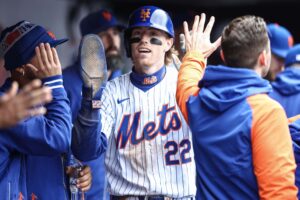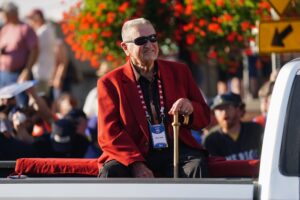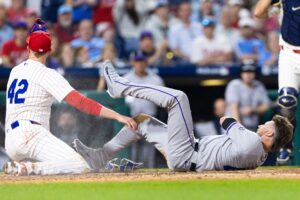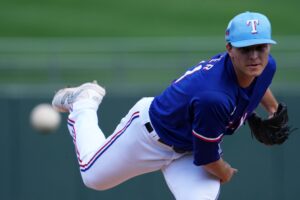The 1980s were an interesting time, to say the least. In world politics, The Cold War was becoming rather lukewarm. The United States had entered the final stretch of its silent fight with the Soviet Union. In pop culture: guitar solos, humongous hair, and multicolored latex lit up the Sunset Strip. Bands like Van Halen, Motley Crüe, and Bon Jovi were popular.
Thrash metal burned in the underground, with Metallica eventually coming out on top. In the sports world, the 49ers ruled the NFL. Meanwhile, the Lakers and Celtics dominated the NBA. Baseball was dominated as well, though by nothing on the field. There was a strike in 1981 and a drug scandal in 1985. However, the sport was rather unique in that no one team dominated the decade. While some teams rocked, others fizzled out.
Unfortunately, the Atlanta Braves were one of the fizzlers. After experiencing unexpected success at the beginning of the decade, they cooled off. In fact, it was one of the sharpest ascensions and declinations in team history. It was almost like a business graph. The red arrow might have shot upwards for a small period. Some semblance of hope might have been injected into the otherwise miserable fanbase. Though, just as quickly, the arrow trended downward. By the end of the decade, the team was back in the cellar and desperate for a way out. They fell pretty hard, so let’s go back and find out how much.
Braves by Decade: 1980s Braves
Slowness and Strikes
In 1980, the team had an average season. Bobby Cox returned as manager, guiding the team to an 81-80 record. This placed them fourth in their division. The offense seemed to rely more on power than consistency. Center fielder Dale Murphy had 33 homers. Third baseman Bob Horner swatted 35. Gary Matthews and Chris Chambliss both added double digit totals. Unfortunately, the batting averages left much to be desired. Shortstop Luis Gomez hit a dismal .191 (53-278) in 121 games.
The pitching corps was nowhere near strong enough to counteract the offense. Phil Niekro won 15 games, but an ERA+ of 102 was just barely above average. The team’s all-around best starting pitcher, Tommy Boggs, won 12. Closer Rick Camp saved 22 games with a sparkling 1.91 ERA. Everyone else was milquetoast at best.
1981 was a very interesting season. The strike caused it to be split into two halves. The Braves were rather unimpressive on both sides. During the first half of the season, they went 25-29. Once the calendar rolled around to the second half, they went 25-27. Overall, their final record (50-56) put them fifth in the division.
The offense stagnated, with a .243 average. Horner helped carry the team (.277 avg, 15 HR, 125 OPS+), while Murphy backed him up (13 HR, 50 RBI, 100 OPS+). Right fielder Claudell Washington hit .291 with a 111 OPS+. However, everyone else fell somewhere in the mediocre category. The pitching was the same, although Camp saved 17 more games. Ageless wonder and Hall of Famer Gaylord Perry spent his only season in Atlanta and won a total of eight games. Niekro went 7-7 with a 3.10 ERA. Collectively as a unit, the team ERA of 3.45 was middling.
Sudden Success
In 1982, the Braves experienced an exception to their rule of being okay. They made the playoffs with an 89-73 record. It was their first year under the guidance of Joe Torre. The offense was the most powerful in the league (146 HR). League MVP Murphy broke out with 36 homers. Horner had 32. First baseman Chris Chambliss hit 20. Washington rounded things out with 16. Although, where the offense was booming, the pitching continued to fumble along. New closer Gene Garber posted a 30 save season. Niekro won 17 games with a 3.61 ERA. Right-hander Pascual Perez went 4-4 with a 123 ERA+ in 16 games. Unfortunately, the success fizzled out in the postseason. The team was swept by the St. Louis Cardinals in the NLCS.
Much like prior decades, the team hung around the top afterwards. 1983 and 1984 saw them place second in the NL West. Murphy would post his second consecutive MVP season in 1983 (.302/.393/.540, 36 HR, 121 RBI, 30 SB, 178 H, 149 OPS+). He was supported by Horner and Chambliss’s 20 homer campaigns.
Unfortunately, the pitching continued to be the weak link. Garber and Niekro both slipped. Steve Bedrosian took over the closer’s role and saved a respectable 19 games. However, as the pitching went, so did the team. They finished 88-74. The next year was the same story. Murphy was the lone bright spot with his third straight 36 dinger season, but the rest of the offense fell flat on its face with a .247 average. The middling pitching couldn’t fix things and the team dropped to 80-82. Although, that was still good for a runner-up spot in the division.
More on the 1980s Braves
Everything Goes South
The cookie really began crumbling in 1985. Torre departed and Eddie Haas took over. He promptly departed after a 50-71 start. Bobby Wine managed the rest of the season. Overall, the team went 66-96. Despite more excellence from Murphy and Horner, the squadron faltered. In fact, Murphy had arguably his best career season (.300 avg, 37 HR, 111 RBI, 185 H, 152 OPS+). Things were quite abysmal on the pitching front though. Perez lost 13 games with an atrocious 6.14 ERA. The lone bright spot in the rotation, Rick Mahler, won 17 games. Closer Bruce Sutter saved 23 games. Unfortunately, everyone else was terrible.
Sadly, bad pitching became the Braves forte. In 1986 and 1987, the team ERA was 3.97 and 4.63, respectively. New manager Chuck Tanner could not turn things around. He went a combined 153-208 during his two-and-a-half seasons at the helm. A manger is only as good as the team he captains. Tanner wasn’t really given anything to work with, aside from the aforementioned Murphy. Even Dale felt the pressure. A spectacular 44-homer, 105-RBI performance in 1987 would be his last hurrah in Atlanta. After a sharp decline, he would be shipped off to the Philadelphia Phillies.
Cellar Dwellers
The decline of Dale Murphy reflected the decline of the team as a whole. In 1988, Tanner left after a 12-27 start. Russ Nixon replaced him, going 42-79. Ultimately, overall, the team finished 54-106. A terrible offense combined with bad pitching to create this monstrosity. The good news though was that the year did bear witness to two notable debuts. Namely, John Smoltz and Tom Glavine.
However, they were far cries from the Hall of Famers they would eventually become. Smoltz and Glavine combined to go 9-24 with a 4.79 ERA. Nobody in the rotation posted a winning record. Four pitchers wound up with double digit losses. Nixon remained on the team through the 1989 season. It was the same old story though.
Brutal pitching combined with bad offense helped to land the team back in the cellar. However, Smoltz and Glavine both improved significantly. Small seeds were being planted. The most successful decade in team history was fast approaching.
Main Image:
Embed from Getty Images
Players Mentioned: Dale Murphy, Bob Horner, Gary Matthews, Chris Chambliss, Luis Gomez, Phil Niekro, Tommy Boggs, Rick Camp, Claudell Washington, Gaylord Perry, Gene Garber, Pascual Perez, Steve Bedrosian, Rick Mahler, Bruce Sutter, John Smoltz, Tom Glavine
Managers Mentioned: Joe Torre, Eddie Haas, Bobby Wine, Chuck Tanner, Russ Nixon






